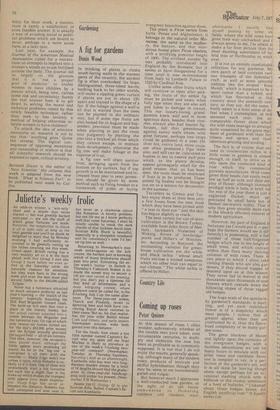A fig for gardens Denis Wood
In thinking of plants to clothe south-facing walls in the warmer parts of the country, the ancient fig is often overlooked. Its large, distinguished, three-lobed leaves, harking back to far older worlds, will make a rippling green curtain if plants are put in about 15ft apart and trained in the shape of a fan. If the foliage against a wall is all that is wanted then the trees can be planted in the ordinary way, but if some ripe fruits are also looked for in August and September, provision must be made when planting to put the roots into purgatory by planting the tree into a bricked pit from which they cannot escape, to restrain their development, otherwise the fig tree will make foliage at the expense of fruit.
A fig tree will often survive frost, springing again from the bottom or by suckers, but if top growth is to be maintained and in creased from year to year, protection should be given by some .method such as fixing hessian to a framework of poles or laying
evergreen branches against them, The plant is Ficus carica from Syria, Persia and Afghanistan; it belongs to the natural order Moraceae, the same as the mulberry, the banyan, and that monstrous house plant Ficus elastica, with a terrifying potential height of 100ft. The civilised, eatable fig was probably introduced into England. by the Romans, but it seems to have disappeared for a time until it was re-introduced from Italy to Lambeth Palace in 1525 by Cardinal Pole.
Unlike some other fruits which will continue to ripen after picking, the fruits of the edible fig must be picked and eaten when fully ripe when they are also soft and liable to damage in transit, This our luxury-loving grandparents knew well and in more spacious days, besides their vineries, always also ,had heated fighouses, tall thin greenhouses against sunny walls where, with good fortune, perhaps two crops could be gathered in a year. (In their hot, native land, three crops are often produced.) Figs were also, and still can be, cultivated as bushes in ten to twelve inch pots which, as the plants develop, appear grotesquely small for the good reason, that, as has been seen, the roots must be restricted if fruit is to be produced. These potted fig bushes can be brought out on to a terrace for decoration in the summer.
Travellers to Greece and Turkey enjoy them at their best only a few hours from the tree, from which they have been picked with " a tear in their eye "and the skin has begun slightly to crack.
The best variety for out-of-door cultivation is the Brown Turkey, available from John Scott of Merriott, Jackman's Nurseries of Woking, Rivers of Sawbridge
. worth and Hillier's of Winchester. According to Bunyard, the outstanding varieties for greenhouse cultivation are the white and black ischia " whose small fruits enclose a honied swee,tness which no other fruit can equal in our climate." The white ischia is offered by Hillier.












































 Previous page
Previous page